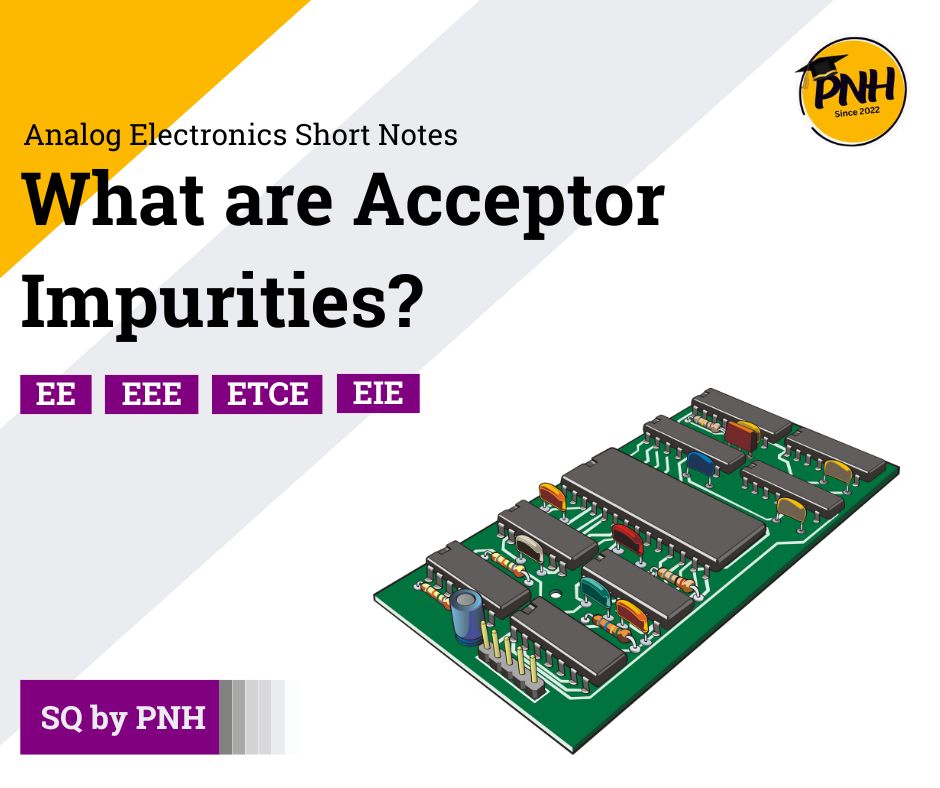In this blog, we are going to know this topic called “What are Acceptor Impurities?” Welcome to Poly Notes Hub, a leading destination for engineering notes for diploma and degree engineering students.
Author Name: Arun Paul
What are Acceptor Impurities?
Acceptor impurities are crucial elements in the world of semiconductors, allowing engineers to manipulate electrical properties for various applications. In this blog, we will delve into “What are Acceptor Impurities?” and explore their role, significance, and applications in the electronics industry.
Definition of Acceptor Impurities
Acceptor impurities are elements introduced into a semiconductor to create holes, which act as positive charge carriers. These impurities typically come from group III elements of the periodic table, such as boron, gallium, or aluminum. When added to a semiconductor, these elements “accept” electrons, creating a deficiency or “hole” in the electronic structure. Learn more about the periodic table here.
How Acceptor Impurities Work
When acceptor impurities are added to an intrinsic semiconductor like silicon, they replace some silicon atoms. Silicon has four valence electrons, while group III elements have only three. This electron deficit creates a hole in the crystal lattice. The movement of these holes contributes to electrical conductivity. Explore silicon’s properties to understand its role as a base material.
P-Type Semiconductors
The introduction of acceptor impurities leads to the formation of P-type semiconductors. In P-type materials, holes are the primary charge carriers, while electrons play a minor role. This type of semiconductor is essential in creating electronic components like diodes and transistors. Learn about P-type materials.
Importance of Acceptor Impurities
Acceptor impurities are vital for tailoring the electrical properties of semiconductors. Without them, creating devices like LEDs, solar cells, and integrated circuits would be impossible. By controlling the concentration and type of impurities, manufacturers can design semiconductors for specific applications. Discover how LEDs work.
Common Acceptor Impurities
Here are the common types of acceptor impurities:
- Boron: Widely used in silicon-based semiconductors for its ability to create stable holes. Learn more about boron.
- Gallium: Often used in compound semiconductors like gallium arsenide. Explore gallium’s applications.
- Aluminum: Another group III element employed for doping. Understand aluminum’s role.
Applications of Acceptor Impurities
Here are the applications of acceptor impurities:
- Transistors
- Acceptor impurities are crucial in forming PNP transistors, used for amplification and switching. Explore transistor technology.
- Solar Cells
- P-type materials are used in the construction of efficient solar cells. Learn about solar cell efficiency.
- Diodes
- P-N junction diodes rely on both acceptor and donor impurities. Understand P-N junctions.
- Integrated Circuits
- Modern ICs require precise doping to function correctly. Discover IC design.
Internal Resources for Learning
For more detailed explanations and notes, visit Poly Notes Hub. You can also find in-depth engineering notes on various topics.
Conclusion
Understanding “What are Acceptor Impurities?” is essential for students and professionals in electronics and semiconductor technology. These impurities enable the development of advanced electronic devices by tailoring the electrical properties of semiconductors. For more resources and detailed notes, explore Poly Notes Hub and enhance your knowledge.
To dive deeper into semiconductors, you can read this comprehensive guide.

